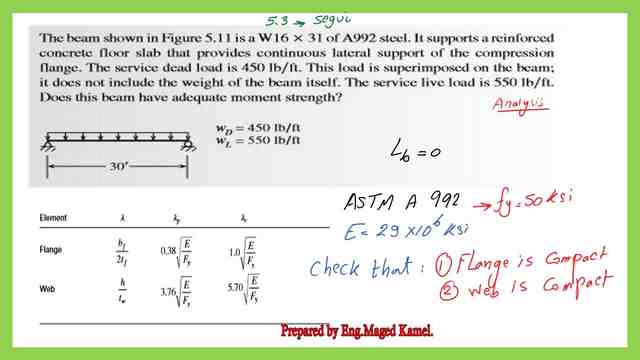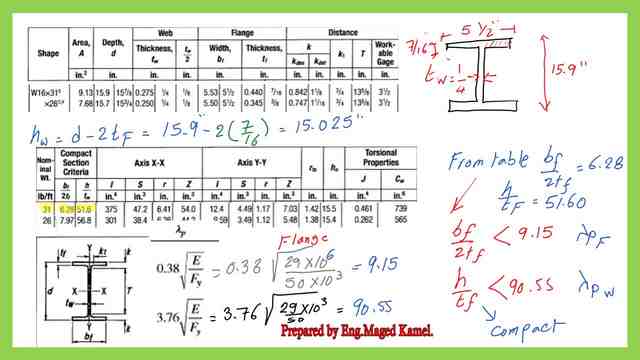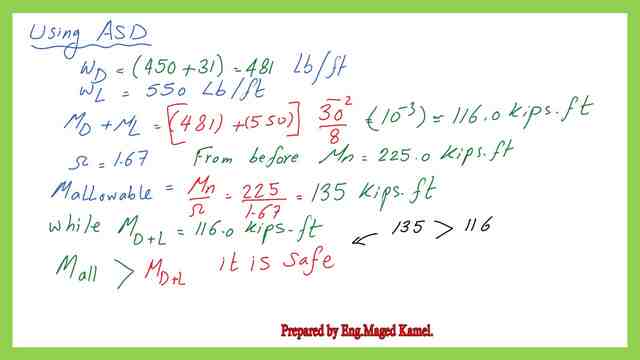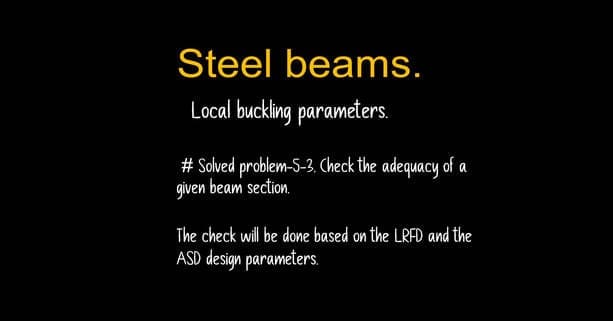How to make an analysis of steel beams? Solved problems.
The difference between analysis and design of steel beam.
The difference between analysis and design problems is that for the analysis the section is given and a check of stress is needed, while for the design the loads are given and it is required to find the section.
Analysis of steel beam at zone-1.
The beam shown in Figure 5.11 is W16x31 of A992 steel, for which, 16″is the overall height, or nominal depth, while 31 is the weight in lbs per linear ft of A992 steel, where Fy=50 ksi, it supports a reinforced concrete floor slab that provides continuous lateral support of the compression flange.
Here it is mentioned that the compression flange is supported continuously, which means that we are dealing with plastic range or zone -1, then our lambda λ between 0 to λp, then Mn= Mp=Fy*Zx.
The beam shown in Figure 5.11 is W16x31 of A992 steel, W16x31, 16″ is the overall height, while the 31 is the weight in lbs per linear ft, of A992 steel, where Fy=50 ksi.


How to check the compactness of both the flange and the web of a beam?
We use Table 1, as the first step of the analysis of steel beam. For W16x31 A=9.13 inch2, the overall depth=15.90 inch, the web thickness =0.275 inches, bf =5.53 inch.
The thickness of the t flange is 7/16 inches.
The controlling factor is 3.76*sqrt(E/Fy) for the web=90.55. The λF, which is 6.28 for the flange is<λp, which is 9.15, then the section will be in the compact zone for the flange, while λw, which is 51.60 is also <90.55. The section will be in the compact zone for the web, which is the first zone.


The first step of the analysis of the steel beam is to get the nominal moment value Mn=Mp=Fy*Zx, from table 1-1, we can get the Zx value, Zx=54.0 inch3.
To get the Mn=Mp=50*54=2700 inch kips. To convert into ft. kips we will divide by 12.
Then Mn=Mp=225.0 kips ft. For the LRFD, Our phi is Φb=0.90, then Φb*Mn=0.90*225.0=202.50 ft. Kips.
The factored moment which is acting on the section should be <= Φb*Mn.
Add dL due to the beam weight, then Md given= Md*1.20=1.20*450, as we can see here, from section W16x3, the weight is 31 lb /ft.
We will multiply by 1.20, we will multiply by 1.20, and add to 450 lb/ft, 1.20D+1.60L=1.20*(450+31)+1.60*(550), then we will divide by 1000, then divide by 1000, then we get 1.457Kips/ft, since the beam is a simply supported beam with span =30′, M=wF*L^2/8= 1.457*30^2/8=164.0 Ft.kips.
The section can carry 202.50 Ft.kips as estimated earlier. For the analysis of the steel beam, this section is adequate for the LRFD design. This is the end of the analysis of the steel beam.


While for the ASD part, Wd= imposed load+own weight=450+31, Wd=481 lb/ft, and the WL=550 lb/ft, adding together for Wt, the Mt=(480+550)*30^2/8/1000=116.0 ft. kips.
This is the total Moment. For Mn =225.0 ft. kips, then, divide by the omega Ωb, which is 1.67. M all =225/1.67=1350.0 ft.kips. The section can carry 135.0 ft. kips and is only subjected to 116.0 ft. kips, the section is safe.
For the analysis of steel beams, this section is adequate for the ASD design. The idea of the example is that the section of the beam carries a slab with studs to provide the continuous bracing, then a section was selected Bf/2tf, lambda λF was< lambda λp flange also, λw is<λp for the web.


A Second solved problem for checking the compactness of a given section.
This is an example from Lindeburg. Establish whether a W21x55 beam of A992 steel Is compact. it is required to make an analysis of steel beam.
There are four options—First A992 steel, with Fy=50 ksi.
For W21x55 the overall depth=20.80″, it is shown highlighted, the web has a Thickness of 3/8″ or 0.375″ t-web.
I draw the section, Bf=8.22″, and its thickness =0.522″.
To estimate the controlling lambda, first, we need to find the value of Tf/2Tf for flange, which is 8.22/2*0.22=7.87, λp for flange =64.70/sqrt(50)=9.15. Then λf<λp for the flange.


For the second part, for the web, we will correct the web thickness as 0.375″, h, as estimate =(20.80-2*0.522)/0.375, where tweb=0.375. If we divide 20.80-2*0.522 by the calculator, then we get hw, hw=19.756″/0.375 = 52.68.


Check against λp which is 640/sqrt(50)=90.55, then 52.55 is <90.55, Since bf/2tf< λp f and hw/tw is< λp t, then option A is correct. This is the end of the analysis of the steel beam.


This is the pdf file used for the illustration of this post.
For bending members, please refer to this link from Prof T. Bart Quimby, P.E., Ph.D. F.ASCE site.
For the next post, Solved problem-4-7-1 how to design a steel beam.

